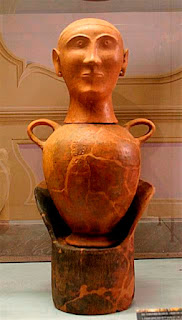A bit of Etruscan Tomb Raiding
If a genie popped out of a bottle and offered me three wishes, my first wish would be to be with Howard Carter when he first entered the tomb of Tutankhamen. So, crawling about in 3000 year old Etruscan tombs has to be a brilliant way of passing the afternoon. True, most of the grave goods have already been legally looted by archaeologists, and the tombs were situated in a very muddy wood, but there was the odd sarcophagus and a few scraps of wall painting left. And we didn’t have to queue, or pay to get in, and we were the only people there.
No one really knows where the Etruscans came from, but they arrived in Italy a long time ago with a language that looks a cross between hieroglyphics and Viking runes.
They knew how to build walls and buildings like the Egyptians, and they made bronze statues (which the Romans melted down) and objects like the Greeks. Their tombs are like the Egyptians too - sloping entrances cut into the ground, subterranean chambers with wall paintings and marble topped sarcophagi surrounded by a collection of objects designed to equip the dead for life after death. It's all very personal. Their funeral urns, like the one above, and their sarcophagi (below), have images of the dead person on them.
You can find the tombs anywhere there’s a rocky outcrop. Some of them have been converted into sheds and storehouses by more recent inhabitants, but others remained buried and have only just been discovered. Heksana, near Orvieto, is only one of a number of known necropoli in this area. We found this tomb beside a farm track only partially concealed by ivy.
Walking through the woods we, quite literally, stumbled on these. There were about seven in all, though the roofs had fallen in on some.
The largest and poshest was closed off with a glass door,
but this is what it would have looked like inside, had we made an appointment to view with the local office of antiquities.
The rest are protected only by tarpaulins - often rotten and full of holes. One of the most interesting tombs was flooded, but we could see a series of tempting chambers opening out beyond the entrance. Next time we’re going equipped for tomb raiding with wellingtons and a torch!
Italy has more history than it can afford, which is a pity, because these beautiful, historic places need protection from the elements and from less scrupulous human beings.
 |
| A funeral urn |
They knew how to build walls and buildings like the Egyptians, and they made bronze statues (which the Romans melted down) and objects like the Greeks. Their tombs are like the Egyptians too - sloping entrances cut into the ground, subterranean chambers with wall paintings and marble topped sarcophagi surrounded by a collection of objects designed to equip the dead for life after death. It's all very personal. Their funeral urns, like the one above, and their sarcophagi (below), have images of the dead person on them.
 |
| Small, bronze religious figures. |
You can find the tombs anywhere there’s a rocky outcrop. Some of them have been converted into sheds and storehouses by more recent inhabitants, but others remained buried and have only just been discovered. Heksana, near Orvieto, is only one of a number of known necropoli in this area. We found this tomb beside a farm track only partially concealed by ivy.
Walking through the woods we, quite literally, stumbled on these. There were about seven in all, though the roofs had fallen in on some.
The largest and poshest was closed off with a glass door,
but this is what it would have looked like inside, had we made an appointment to view with the local office of antiquities.
The rest are protected only by tarpaulins - often rotten and full of holes. One of the most interesting tombs was flooded, but we could see a series of tempting chambers opening out beyond the entrance. Next time we’re going equipped for tomb raiding with wellingtons and a torch!
Italy has more history than it can afford, which is a pity, because these beautiful, historic places need protection from the elements and from less scrupulous human beings.













I swear you do these posts just to make us all want to travel to Italy!
ReplyDeleteOz archaeology tends to be less dramatic. There are traces of Aboriginal people in many places if you know what to look for. But usually they are very faint and easily missed
卐 Etruscans = Archaic Greeks = Brahmins = Hittites = ancient Lithuanians = ancient Armenian = ancient Georgian = Babylonian = Sumerians = Cyprusian = ancestors(pre-flood) of Caucasians = Indo-European race (White Indians) = Worshiped Buddhas 卍
ReplyDelete卐 Ancient Greek race (whit Indians/Indo-Europeans) 卐
ReplyDeletehttp://personalzz.weebly.com/uploads/5/0/0/8/5008251/2932904_orig.png